The Last Child of My Lai

Around 11:30 on March 16, 1968, Captain Ernest Medina ordered a ceasefire of US troops under his command in the South Vietnamese village of My Lai 4. After nearly four hours of gunfire, there was silence. There was silence, even though the order only applied to American soldiers. There was silence because none of the Viet Cong in the village were firing back. There was silence because the Viet Cong had never fired on US troops that day. There was silence because there were no Viet Cong in the village that day. There was silence because most of the people who were in the village that day were dead. More
The post The Last Child of My Lai appeared first on CounterPunch.org.

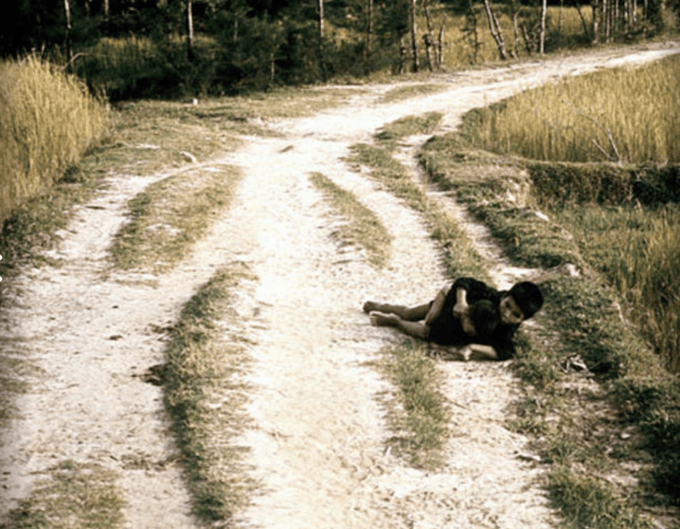
Two Vietnamese boys, Truong Bon and Truong Nam, were on the road to My Lai 4 moments before they were shot and killed. Photo: Ron Haeberle (Library of Congress).
Around 11:30 on March 16, 1968, Captain Ernest Medina ordered a ceasefire of US troops under his command in the South Vietnamese village of My Lai 4. After nearly four hours of gunfire, there was silence. There was silence, even though the order only applied to American soldiers. There was silence because none of the Viet Cong in the village were firing back. There was silence because the Viet Cong had never fired on US troops that day. There was silence because there were no Viet Cong in the village that day. There was silence because most of the people who were in the village that day were dead.
The gunfire began at 7:50 in the morning when two Huey gunships began strafing the boundaries of the village to provide cover for Medina’s advancing platoons. The Hueys shot anyone who fled the village, under the assumption they must be Viet Cong.
A mere five minutes later, Charlie Company was already on the ground, under the command of Lieutenant William “Rusty” Calley. A radio report from Calley’s platoon claimed they’d already killed 15 Viet Cong and had as yet encountered no resistance. They continued killing for the next 210 minutes. They yanked families out of their hooches, lined them up along a ditch, and shot them. They shot people working in the fields. They shot people running for cover. They shot the wounded. They shot people who tried to aid and comfort the wounded. They shot the young and the old. They shot mothers and grandmothers. They shot everyone they saw. What they didn’t shoot was anyone who shot at them. What they didn’t shoot was anyone who had a gun. What they didn’t shoot was any Viet Cong.
By 11:30, when Medina issued his ceasefire order, US forces had killed as many as 502 people. When they combed through the piles of bodies, and searched the huts, bunkers and tunnels, they found three weapons, all of them US-made. In the entire operation, no US troops were injured by enemy fire. The closest any US troops came to being shot that day was when Warrant Officer Hugh Thompson, and his two crewmates, Lawrence Colburn and Glenn Andreotti, intervened to keep GIs in the 2nd Platoon from killing a group of Vietnamese women and children cowering in a bunker. One other US soldier shot himself in the foot to avoid being forced to kill wounded civilians.
+++
It was Hugh Thompson who blew the whistle on the massacre. From his helicopter, he and his crew witnessed the slaughter. They saw what looked to be Vietnamese women and children marched to a ditch and shot. What they didn’t see was any enemy fire. They didn’t see any Viet Cong, at all. Thompson and his crew were so appalled, they landed in the free-fire zone. Almost immediately after touching down, they spotted a Vietnamese woman with a gaping chest wound. Thompson called for a Medivac to help her. Before it arrived he saw a US soldier with Captain’s bars on his helmet approach the woman, kick her with his boot, take a few steps back and riddle her body with bullets from his M-16. “She’s history and I’m sitting here,” Thompson said to Colburn. “My God, he just killed her.” The man with the Captain’s bars and the M-16 was Ernest Medina.
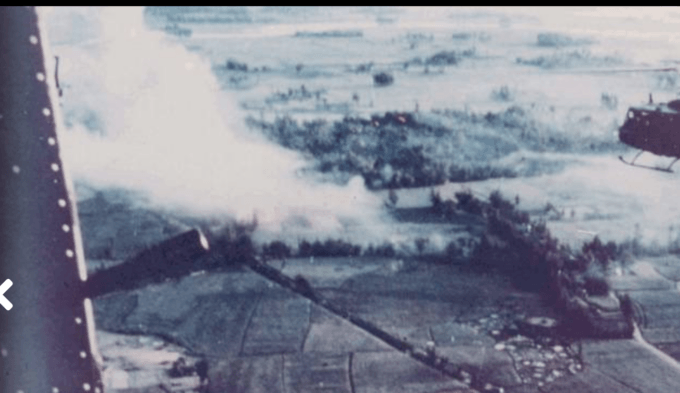
The burning of My Lai 4 as seen from a US Army helicopter. Photo: Library of Congress.
Thompson wasn’t the only one in the air that day with a view of the massacre. So were three of the men who ordered the raid on Pinkville, the name the US Army had given to the Son My villages. The airspace at 1,000 feet was reserved for the helicopter carrying Lt. Colonel Frank Barker, at 1,500 feet the helicopter of Colonel Oran Henderson circled the villages and rice paddies, and above it all was the helicopter carrying Major General Samuel Koster, all of whom would later be complicit in covering-up the mass killing that took place below.
From their airborne observation posts, circling counter-clockwise around the villages, the commanders claim to have seen things that didn’t happen and missed things that did. What the commanders claim they saw was first, a fierce battle between the US Army and the 48th Local Force Battalion of the People’s Liberation Army (Viet Cong); and second, a battle that went according to plan. What the commanders claim they didn’t see were piles of civilian bodies, the deliberate killing of women and children, rapes and gang rapes of women as young as 12, the wounded being kicked, stabbed with bayonets and shot, bodies being mutilated.
If the “battle” of My Lai went according to plan, what was the plan? And who came up with it?
At the operational level, the raid on the four hamlets of Son My–My Lai 4, My Khe 4, Binh Tay, and Binh Dong–was about retaliation for the Tet Offensive a month earlier that blew away the Johnson administration’s propaganda about how the US had turned the tide and winning the war. In that respect, the planners of the My Lai massacre went right to the top: General Westmoreland, General Earl Wheeler (chair of the Joint Chiefs of Staff), Defense Secretary Clark Clifford, and LBJ, himself.
Both the CIA and Army intelligence identified Pinkville as the staging area for the Viet Cong forces that rose up across Quảng Ngãi province during Tet and they wanted Pinkville to pay the price. Normally, the US Army went out on patrol alongside ARVN troops, but the spooks wanted the raid on Pinkville to be a US-only operation. Why? The official reason was they didn’t trust the ARVN troops not to leak the plans to the Viet Cong. But the real reason may well have been that they didn’t trust to ARVN troops to go along with the nature of the plan itself, which was to “neutralize” the village, kill its inhabitants (who they claimed were all VC), slaughter the livestock, burn the hooches, and poison the wells with rotting animal carcasses.
The neutralization of Pinkville was abetted by the CIA’s Phoenix Program, which had been created a year earlier to target, detain, interrogate, torture and kill suspected Viet Cong. Phoenix’s man on the ground in Quang Ngai province was Nguen Duc Te, who described My Lai 4 as a “combat village of the Communists” and handed over to his handlers at the CIA a so-called “Black List” of several hundred names of villagers, many of them women, suspected of aiding or sympathizing with the Viet Cong. The Phoenix Program operated under a monthly quota system of “neutralized” Viet Cong. Wiping out My Lai would put a big number on the body count board.
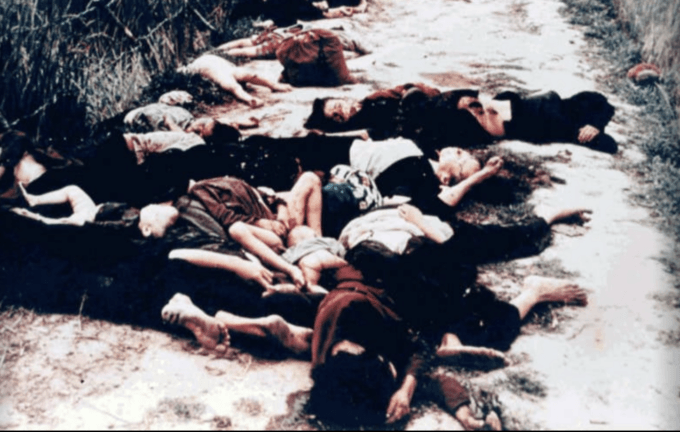
Bodies of women and children on the road to My Lai 4. Photo: Ronald Haeberle. (Library of Congress.)
The battle plan for Pinkville wasn’t committed to paper, for no obvious reasons. But the objectives trickled down the chain of command from above. Neutralize the forces behind Tet, wipe out their supplies and local support networks, destroy their bunkers and tunnels, burn their food sources, and make it impossible for those who survived to return.
The intelligence officers behind the massacre–the CIA’s Robert Ramsdell and the Army’s Eugene Koutuc–made it clear to the commanders–Koster, Henderson, Barker, and Medina–that the Pinkville hamlets were VC strongholds and that all of the people in the hamlets at the time of the raids should be considered VC. The civilians, Ramsdell assured the commanders, would have all left the villages for the market by 7 am. Ramsdell said they should expect to encounter around 450 VC in Pinkville. Ramsdell’s estimate for the number of people in Pinkville wasn’t far off. But none of them were members of the 48th Battalion.
Then again none of that seemed to matter. There would be no distinctions made between VC and civilian. There would be no effort to make a distinction. The villages were considered a stronghold of the VC; therefore, everyone and everything in them was part of the support network of the “enemy.” As Barker told Medina, his troops had permission to “destroy the village, to burn down the houses, to destroy the food crop that belonged to the Viet Cong and to destroy their livestock.”
The night before the raid Medina briefed his anxious troops. Many of the GIs in Charlie Company, including 2nd Lieutenant Calley, were new to Vietnam. They’d seen little action and the action they had seen was terrifying: mines, booby traps, ambushes. A few days earlier along the Song Diem Diem River, Charlie Company had suffered 28 casualties, including five killed, and never even seen the enemy.
Medina’s speech to his soldiers played on these fears and desires for revenge. He told them they would be outnumbered two-to-one by the forces who’d just killed and wounded their friends. He said the landing zone would be hot and that they should expect heavy casualties from enemy fire. Medina said that they should consider My Lai 4 a free-fire zone. He told the troops everyone in the village should be considered VC.
Calley later said Medina’s orders were clear: “Our job is to go in rapidly and to neutralize everything. To kill everything.” Medina’s radio officer, John Paul, recalled that Medina said only VC and VC sympathizers would be in the village, and “I understood them to be annihilated.” PFC Charles Groover said the message he got from Medina was: “Wipe it out. Burn the village. Every living thing. Just kill it. Exterminate.” Herbert Carter claimed Medina closed his talk by saying, “When we go into My Lai 4, it’s open season. When we leave, nothing will be living.”
The troops landed outside My Lai 4 around 7:50, and despite not taking any enemy fire, almost immediately started shooting at people. One of the first to die was an old man, who despite having obeyed a soldier’s orders to stop running and put his hands up, was machine-gunned. Another elderly man was found curled up in a hut. Sgt. David Mitchell barked out: “Shoot him.” And he was shot. A few minutes later Mitchell threw a grenade into a hut, killing several women and children. Thus it began.
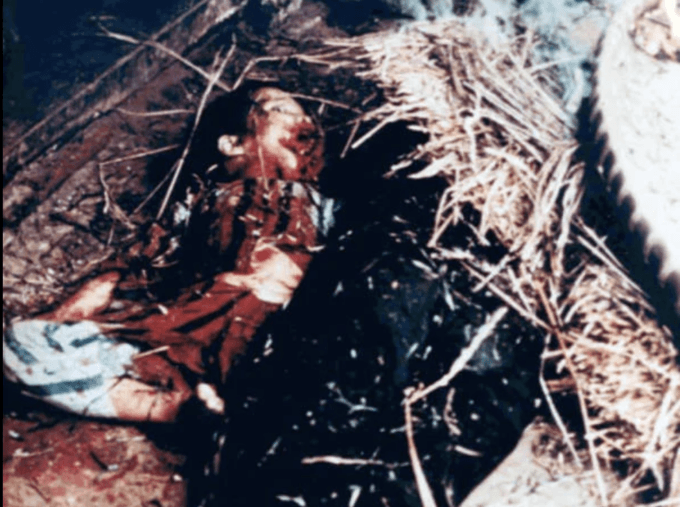
Bodies of an infant and its mother outside of their home. Photo: Ron Haeberle. (Library of Congress)
In the center of the village, 20 women and children were shot in the back, while they were praying at a Buddhist shrine. An old woman was shot in the stomach at close range with a grenade launcher. An old man was shot in the head, as his three grandchildren clung to him. Another old man was thrown into a well, and then blown up with a hand grenade.
Calley’s troops moved through the village, pulling people out of huts. Around 8:00 Medina radioed him complaining about how slow the operation was going. Calley responded: “I’ve got a lot of Vietnamese here.” Medina snapped back: “Well, get rid of them.”
Calley knew what Medina wanted and began to move the group of several dozen women and children toward a ditch, when he spotted one of his privates by the side of the road, clutching a woman by the hair. His pants were at his ankles. The woman was on her knees, an arm around her child. The private, a soldier named Dennis Conti, had his rifle jammed to the head of the young girl, while he demanded oral sex from its mother. Calley testified at his trial that he ran over to Conti, shouting: “Get your damn pants on and get over where you’re supposed to be.”
There would be at least nine women raped that day, several of them children. The sexual assaults didn’t bother Calley. What bothered Calley was that the rapes delayed the implementation of the plan. And the plan was to kill. To pile up the dead. To accumulate a body count. “If a GI is getting a blow job,” Calley told journalist John Sack, “he isn’t doing his job. He isn’t doing what we’re paying him to do. He isn’t destroying Communism. He isn’t combat-effective.”
Medina radioed again, furious at the delay.
“Why did you disobey my order?”
“I have these bunkers,” Calley tried to explain.
“To hell with the bunkers!” Medina shouted.
“And these people, and they aren’t moving too swiftly….”
“I don’t want all that crap,” Medina ordered. “Now damnit, waste all those goddamn people.”
After the second call with Medina, Calley summoned PFC Paul Meadlo, a farm kid from New Goshen, Indiana, and pointed at the group of about 80 Vietnamese.
“You know what to do with them, don’t you?”
“Yes,” Meadlo replied.
Calley wandered off for a few minutes, then came back, barking at Meadlo.
“So why haven’t you killed them, then?”
“I didn’t know we were supposed to kill the people!” Meadlo protested.
“Let’s kill them,” Calley snapped.
And so they did. A year later Meadlo, now out of the Army after losing his foot to a landmine, told William Wilson, an investigator from the Army’s Inspector Generals’ office: “Calley opened up first and then I joined in. We stood about 10 to 15 feet away from them. Calley started shooting. Then he told me to start shooting. I used more than one clip. I think I used four or five clips.” There were 17 rounds to each clip.
As Calley and Meadlo machine-gunned the Vietnamese in the ditch, another member of the platoon, Michael Turner, watched from a nearby dike. After they stopped shooting, Calley and Meadlo began walking toward Turner when a young girl approached them with her hands held up. “Lieutenant Calley,” Turner testified at Calley’s trial, “raised his rifle and shot her several times and she fell over into a rice paddy.” As the girl bled out, Calley shouted at his men to stop looking and get moving.
An hour or so later, Calley ordered his fire team leader Ronald Grzesik to burn all the remaining buildings in My Lai 4. As he approached the hamlet, Grzesik encountered Meadlo on his knees, crying near the ditch filled with entangled bodies. Grzesik asked Meadlo what was wrong and he said Calley had ordered him to kill these people.
The My Lai killings weren’t indiscriminate. The GIs weren’t killing just anyone. They were killing everyone. They were killing everything: chickens, pigs, dogs, rabbits, cows, water buffalo, grandmothers, and children. Young girls, wounded boys, toddlers, infants. More than half of the 504 people murdered in Pinkville that morning were minors. The GIs were following orders and the orders were: to kill everything. Kill everything that breathes. Kill everything that moves.
Looking for a precedent? See Wounded Knee. Think things have changed? See El Mozote, Fallujah and Mosul.
Most of the GIs on the ground that day stayed silent while they were still in Vietnam about what went down in Pinkville, even the ones–and there were several–who didn’t kill unarmed civilians, fearful that they might be fragged by those who did.
The cover-up of the My Lai murders began within hours. Less than hours. It began as soon as Barker learned that there was a helicopter crew (Ridenhour’s) accusing GIs of killing unarmed, non-resisting civilians. Many suspect Barker radioed Medina and ordered him to issue the sudden ceasefire. The perfunctory investigation that followed was a case of the Army commanders reviewing the operation they ordered, observed and declared a victory. The investigation was so cursory Col. Oran Henderson didn’t even interview Calley. When this was exposed as a cover-up by Ridenhour and Hersh, the Army then investigated its own cover-up. It was a case of the perpetrators investigating their own crimes.
Even so, what happened at My Lai was not a mystery. The only ones kept in the dark were the people who funded it: the American taxpayers. Everyone on the ground that day knew what happened and why. Everyone in the air saw the slaughter below and the lack of enemy fire. Hugh Thompson and his crewmates tried to stop the killing and reported it as a war crime within hours. Ron Haeberle photographed the atrocities as they were committed. An Army reporter, Jay Roberts, watched civilians being sexually assaulted, killed and their bodies mutilated. The local Vietnamese counted the dead and buried the bodies the next day. Within forty-eight hours, the Census Grievance Committee in Quang Ngai City reported that US troops had massacred civilians “both young and old.”
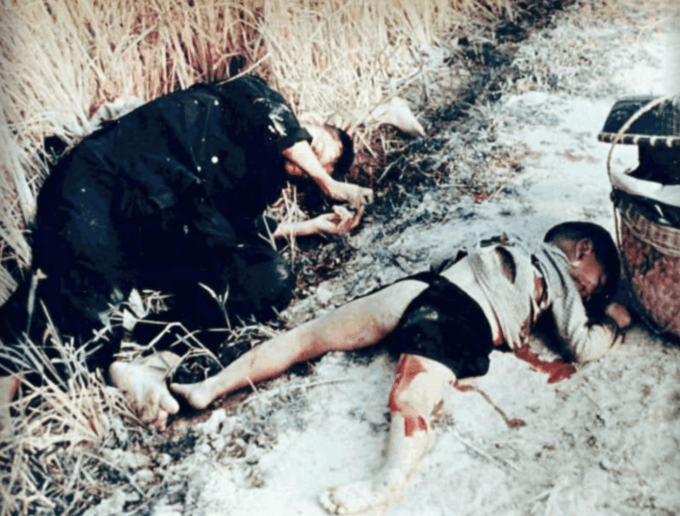
The bodies of Truong Nhi and his 9-year-old son, Truong Cu Ba, on the road to My Lai 4. Photo: Ronald Haeberle. (Library of Congress)
And so matters stood for more than a year, until a former helicopter gunner named Ron Ridenhour, who later became a prize-winning investigative reporter, tracked down rumors of the massacre at Pinkville, interviewed participants, wrote up their accounts, and sent a five-page letter detailing his findings to the Pentagon and Members of Congress. Ridenhour’s report initiated a review of the bloodbath by the Pentagon’s Inspector General’s office. The Pentagon closed ranks and made Rusty Calley–the semi-literate second lieutenant on one of his first patrols–the scapegoat for an atrocity whose ultimate architects went to the very top of the command structure. The brass thought they could control the damage, and keep the court martial quiet. A colonel told Calley everything would be okay if he kept his mouth shut, and stayed silent: “There’s no need to publicize this thing. The US Army won’t publicize it, if you won’t.” But it was Calley whose name would be attached forever to My Lai. Calley who would be tried for the pre-meditated murder of what the indictment called “111 Oriental human beings,” Calley who would be convicted, sentenced to life in prison and, after spending only four months in the stockade, have his sentence commuted by Richard Nixon, who called Calley “a good soldier” who was “getting a bum rap” for an “isolated incident.”
Then in November 1969 the story of My Lai, and its cover-up, slowly began to crack open publicly: first in a front-page story in the Alabama Journal by Wayne Greenshaw disclosing the Army’s investigation into Calley’s actions. Then a day later in Seymour Hersh’s more detailed account, including an interview with Calley, that was distributed to papers across the country by David Obst’s Dispatch News Service.
Nixon became obsessed with My Lai. Not the massacre, but the exposure of the mass killings, which he thought, rightly, would deflate what little support remained for the war and doom his “peace” through a bombing plan. He was obsessed with the “talkers” and ordered John Ehrlichman to put together a “My Lai Task Force” (Agnew, Kissinger, Herb Klein, Patrick Buchanan and Lyn Nofzinger) to silence and discredit Ridenhour (“this Goddamn what’s his name!”) Haeberle (“His parents were Cleveland peaceniks”) and Hersh (“a no-good son of a bitch.”) Negative stories were planted in the press and Ridenhour and Hersh were tailed by Ehrlichman’s Watergate break-in gang of “plumbers.” Nixon said he wanted Hugh Thompson “discredited,” even if they had to do some “dirty tricks” at “not too high a level.” Nixon wanted the Task Force to undermine any military trials by concealing or destroying key evidence, leaking forged documents and tarring the potential witnesses as biased or out for money. “It’s the dirty rotten Jews from New York who are behind it,” Nixon insisted, perhaps unaware that the people he suspected of being New York Jews, Ridenhour and Hersh, were from Oakland and Chicago, respectively.
+++
When Medina finally called the ceasefire, he sat down with his platoon near a pile of bodies of women and children, and began to eat lunch in a cloud of smoke from a nearby hooch where the inhabitants had been blown up by a grenade and the thatch roof set on fire with a Zippo lighter. The smoke stank of burning flesh.
There was silence as they ate. Then a burst of gunfire ripped the quiet.
There had been a boy standing along the trail to the village. A child, five or six years old. He had been shot and was bleeding from a wound in his leg. He wasn’t crying. He was just standing there, staring blankly as the GIs streamed past him. The boy was silently looking at them as if he were dazed or in shock. The photographer Ron Haeberle came upon him and started to take the boy’s photo.
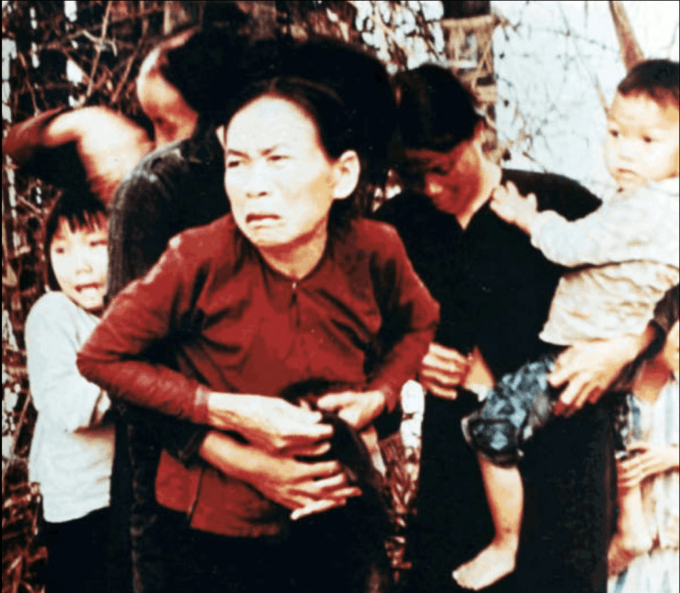
A group of Vietnamese children and women, one of whom had just been sexually assaulted, moments before they were murdered. Photo: Ron Haeberle (Library of Congress).
Haeberle himself was in a daze. A few minutes earlier he had taken what would become his most famous photograph, an image that would come to symbolize the horrors of My Lai. It depicted seven Vietnamese women and children, terror on their faces, clustered together, holding each other, outside of a hut. One of the women had just been raped and she was clutching at her torn shirt. Shortly after he snapped the shutter on his camera, two soldiers opened fire. The women collapsed to the ground. When Haeberle looked up, only a child was still standing. Then they shot him. Right in front of a photographer. “It’s just that they didn’t know what they were supposed to do,” said Haeberle’s sidekick Jay Roberts, the Army reporter. “Killing them seemed like a good idea. So they did it.” Michael Terry, the conscience-stricken Mormon interviewed by Ridenhour, put it more starkly: “It was a Nazi-type thing.”
As Haeberle focused his camera lens on the wounded, silent young boy now in front of him, he heard another GI coming along the trail. The soldier stopped, knelt next to the trembling kid, took his M-16 off his shoulder, aimed and shot him three times. The last child of My Lai. Then he stood, flashed Haeberle “the coldest, hardest look” and continued down the path, into the silence.
Sources
My Lai: Vietnam, 1968, and the Descent Into Darkness
Howard Jones
Oxford (2017)
Four Hours in My Lai
Michael Bilton and Kevin Sim
Penguin (1992)
My Lai 4: A Report on the Massacre and Its Aftermath
Seymour Hersh
Random House (1970)
Cover-Up: the Army’s Secret Investigation of the Massacre at My Lai 4
Seymour Hersh
Random House (1972)
The Peers Inquiry of the Massacre at My Lai
Robert Lester, Ed.
University Publishers (1997)
Medina
Mary McCarthy
Harcourt-Brace-Jovanovich (1972)
The Reality of the My Lai Massacre and the Myth of the Vietnam War
Marshall Poe
Cambria Press (2023)
Lieutenant Calley: His Own Story
John Sack
Viking (1971)
After Tet: The Bloodiest Year of the War
Ronald H. Spector
Free Press (1993)
The Deaths of Others: The Fate of Civilians in America’s Wars
John Tirman
Oxford (2011)
Kill Everything That Moves: The Real American War in Vietnam
Nick Turse
Henry Holt (2013)
“My Lai,”
Michael Uhl
Mekong Review,
Feb-Apr. 2018. Vol.3, No. 2.
The Phoenix Program
Douglas Valentine
William Morrow (1990)
This first appeared in the March 19, 2023 edition of CounterPunch +.
The post The Last Child of My Lai appeared first on CounterPunch.org.
